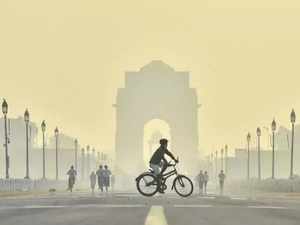 Agencies
AgenciesLockdowns have improved the air quality in Delhi-NCR this year as well but not as effectively as last year due to the 2021 curbs being shorter and lesser stringent, the Centre for Science and Environment (CSE) has found in a study.
Meteorology would be partly responsible for this trend, but it could also be a reflection of weakening of pollution control-measures and efforts in the city and region, it said.
Traffic intensity was also comparatively higher in 2021, it added.
This year, restrictions in Delhi started on April 6 in the form of night-curfews and weekend lockdowns with complete lockdowns being imposed on April 19.
The imposition of partial-lockdown lowered PM2.5 pollutant levels by 20 per cent; while the complete lockdown brought the average down by further 12 per cent, according to the CSE analysis.
"In 2020, partial lockdown started on March 12 with hard lockdown kicking in on March 25, which was lifted in phase-wise manner from May 18. Then the partial lockdown also brought PM2.5 levels down by 20 per cent, but the hard lockdown reduced it by another 35 per cent," the CSE said.
Lifting of restrictions from May 18 had led to 28 per cent rise in PM2.5 levels, it said.
The green think-tank also said the lockdown summers in 2020 and 2021 have been 25 to 40 per cent cleaner as compared to the summer of 2019.
It also said that spring of 2021 (January-March) has recorded the highest pollution levels for the season since 2019.
Normally, PM2.5 levels have a seasonal cycle with winter being the most polluted and monsoon season being the cleanest. Spring (January to March) acts as a transitional period between the two extremes – winter and summer
A significant drop in PM2.5 levels happens as the weather warms up and wind picks up speed during spring.
"There was a 26 per cent drop between winter of 2018 and spring of 2019. In 2020, this drop increased to 36 per cent due to pollution control measures in place and also imposition of partial lockdowns in March 2020. But this downward trend in spring pollution did not continue this year, with seasonal drop limited to 18 per cent," the report said.
"In fact, spring this year has been 31 per cent dirtier than 2020 and 8 per cent dirtier than 2019," it said.
The CSE analysis also showed that there were 27 "very poor" days in terms of air quality this February-March compared to 17 in 2020 and 12 in 2019.
Days meeting the air quality standard also plummeted this spring to just two. The year 2020 had 16 and 2019 had six days when the standard was met, it said.
Meteorology would be partly responsible for this trend, but it could also be a reflection of weakening of pollution control-measures and efforts in the city and region, it said.
Traffic intensity was also comparatively higher in 2021, it added.
This year, restrictions in Delhi started on April 6 in the form of night-curfews and weekend lockdowns with complete lockdowns being imposed on April 19.
The imposition of partial-lockdown lowered PM2.5 pollutant levels by 20 per cent; while the complete lockdown brought the average down by further 12 per cent, according to the CSE analysis.
"In 2020, partial lockdown started on March 12 with hard lockdown kicking in on March 25, which was lifted in phase-wise manner from May 18. Then the partial lockdown also brought PM2.5 levels down by 20 per cent, but the hard lockdown reduced it by another 35 per cent," the CSE said.
Lifting of restrictions from May 18 had led to 28 per cent rise in PM2.5 levels, it said.
The green think-tank also said the lockdown summers in 2020 and 2021 have been 25 to 40 per cent cleaner as compared to the summer of 2019.
It also said that spring of 2021 (January-March) has recorded the highest pollution levels for the season since 2019.
Normally, PM2.5 levels have a seasonal cycle with winter being the most polluted and monsoon season being the cleanest. Spring (January to March) acts as a transitional period between the two extremes – winter and summer
A significant drop in PM2.5 levels happens as the weather warms up and wind picks up speed during spring.
"There was a 26 per cent drop between winter of 2018 and spring of 2019. In 2020, this drop increased to 36 per cent due to pollution control measures in place and also imposition of partial lockdowns in March 2020. But this downward trend in spring pollution did not continue this year, with seasonal drop limited to 18 per cent," the report said.
"In fact, spring this year has been 31 per cent dirtier than 2020 and 8 per cent dirtier than 2019," it said.
The CSE analysis also showed that there were 27 "very poor" days in terms of air quality this February-March compared to 17 in 2020 and 12 in 2019.
Days meeting the air quality standard also plummeted this spring to just two. The year 2020 had 16 and 2019 had six days when the standard was met, it said.
Read More News on
(Catch all the Business News, Breaking News, Budget 2024 News, Budget 2024 Live Coverage, Events and Latest News Updates on The Economic Times.)
...moreDownload The Economic Times News App to get Daily Market Updates & Live Business News.
Subscribe to The Economic Times Prime and read the ET ePaper online.
Read More News on
(Catch all the Business News, Breaking News, Budget 2024 News, Budget 2024 Live Coverage, Events and Latest News Updates on The Economic Times.)
...moreDownload The Economic Times News App to get Daily Market Updates & Live Business News.
Subscribe to The Economic Times Prime and read the ET ePaper online.





